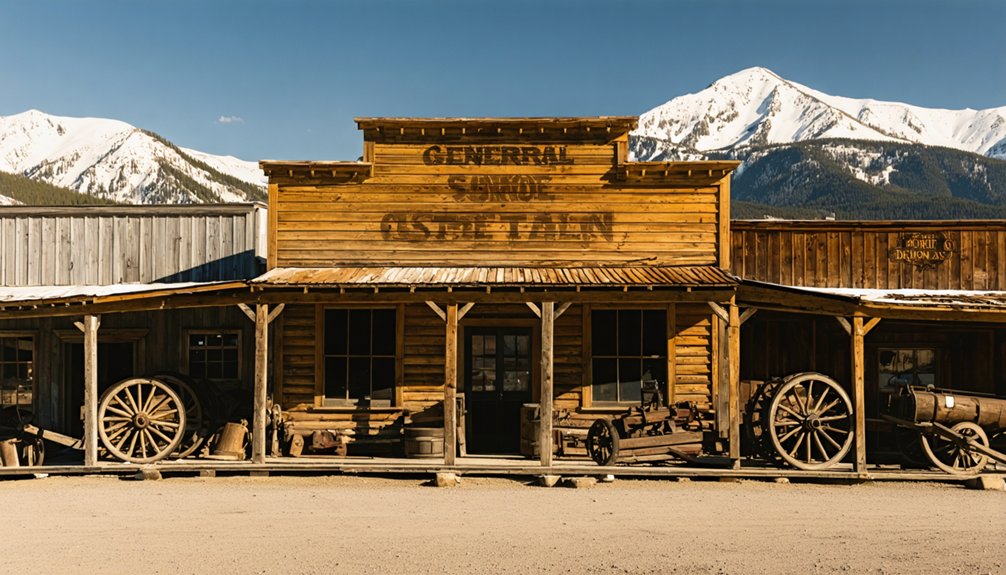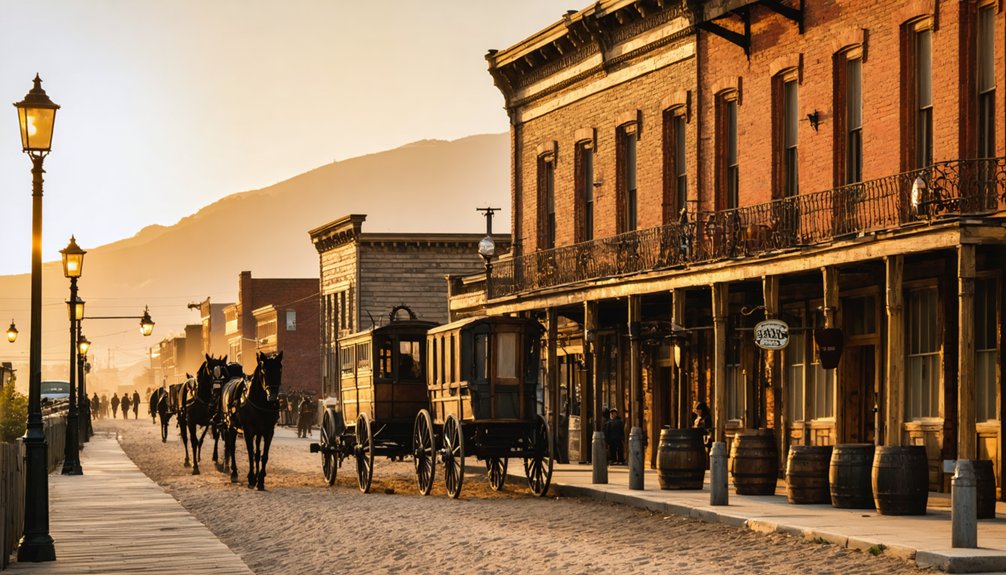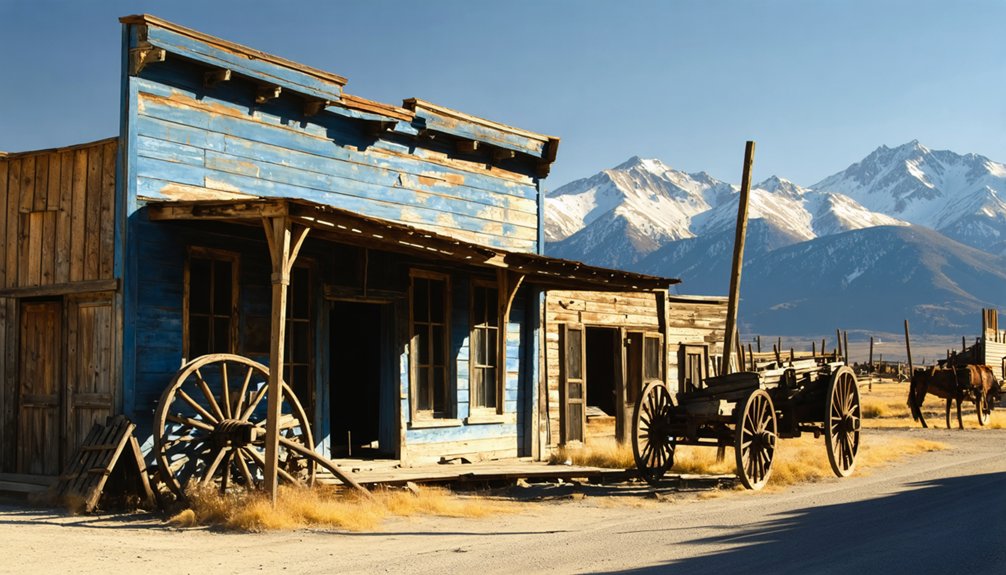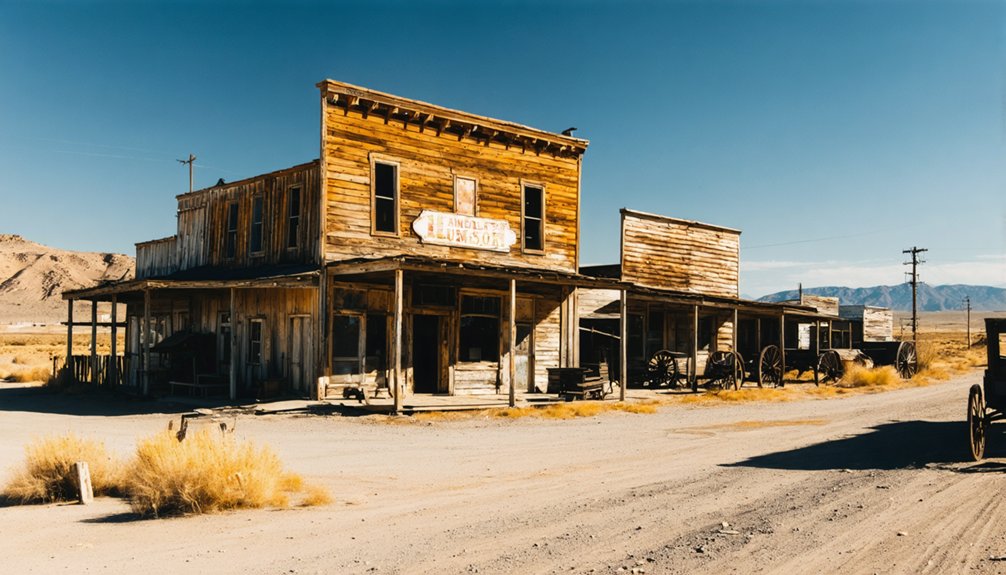You’ll discover America’s authentic Wild West heritage in remarkably preserved mining towns like Tombstone, Arizona, where original 1880s buildings and wooden boardwalks transport you to the era of the O.K. Corral. Virginia City’s Victorian mansions showcase the wealth of Nevada’s $180 million Comstock Lode, while Bodie’s 170 structures remain in “arrested decay.” From Deadwood’s gold rush streets to Bisbee’s Copper Queen Mine, these frontier towns hold countless stories of boom, bust, and adventure.
Key Takeaways
- Bodie, California maintains 110-170 original structures in “arrested decay,” offering an authentic, untouched glimpse into gold rush life.
- Virginia City, Nevada preserves over 100 period buildings and features Victorian architecture along C Street’s historic district.
- Tombstone, Arizona showcases original 1880s buildings, wooden boardwalks, and regular Wild West reenactments at the O.K. Corral.
- Columbia, California contains America’s largest collection of original gold rush-era brick buildings, with 30 structures as National Historic Landmarks.
- Bisbee, Arizona features the historic Copper Queen Hotel, preserved Victorian architecture, and offers underground mine tours.
Why Tombstone, Arizona Remains the Ultimate Wild West Experience
When prospector Ed Schieffelin struck silver in Arizona Territory in 1878, he unknowingly laid the foundation for what would become America’s best-preserved Wild West town.
Today, you’ll experience Tombstone legends firsthand as you walk the same wooden boardwalks where Wyatt Earp and Doc Holliday once strode, past original 1880s buildings that housed over 100 saloons during the town’s silver boom.
Unlike other historic mining towns, Tombstone maintains its authenticity through meticulous preservation. The town’s advanced infrastructure included fresh seafood deliveries from Baja, Mexico, showing its remarkable sophistication for a frontier settlement.
You can descend 100 feet into the Good Enough Mine to see actual silver veins, witness Wild West reenactments of the famous O.K. Corral gunfight, and step into working saloons that retain their 19th-century architecture.
Visitors can explore the historic Boothill Graveyard, restored in 1923, where notable pioneers of the Old West were laid to rest.
The town’s designation as a National Historic Landmark guarantees that its rugged frontier spirit endures.
The Silver Legacy of Virginia City, Nevada
You’ll discover Virginia City’s transformation from a bustling 1859 silver mining settlement into one of America’s wealthiest towns, where the Comstock Lode’s $180 million yield funded lavish Victorian mansions and sophisticated cultural venues.
Today, with about 1,000 residents remaining, the city maintains its authentic historical character while welcoming visitors to explore its rich past.
The city’s phenomenal wealth, generated by innovations like square-set timbering in the Consolidated Virginia and California mines, financed the construction of ornate opera houses, banks, and churches that still stand today. The legendary Silver Kings John Mackay and his partners generated an astounding $3 million monthly during their peak production years.
Walking through Virginia City’s remarkably intact historic district, you can explore more than 100 period buildings featuring elaborate Italianate facades, cast-iron storefronts, and distinctive Western boom-town architecture that earned it National Historic Landmark status.
Mining Wealth Transforms Town
The discovery of the Comstock Lode in 1859 transformed Virginia City, Nevada from a modest settlement into America’s wealthiest mining boomtown.
You’ll find evidence of this mining prosperity everywhere, from the remnants of advanced mining operations to the architectural grandeur that silver built.
The economic transformation was staggering:
- Mining wages soared to become among the highest in the world
- The population exploded to 25,000 by the mid-1870s
- Nevada produced over half of all U.S. precious metals by 1876
As you explore the town’s historic districts, you’ll notice how the Comstock’s wealth shaped every aspect of life.
The mining boom attracted a diverse mix of skilled workers and entrepreneurs worldwide, establishing Virginia City as a vibrant commercial hub with advanced infrastructure and cultural institutions. The wealth generated helped support the Union’s Northern cause during the Civil War. The city’s immense silver deposits and production earned Nevada its enduring title as the Silver State.
Preserved Victorian Architecture Legacy
Mining wealth’s lasting legacy stands proudly preserved in Virginia City’s extraordinary collection of Victorian architecture.
You’ll find magnificent Second Empire mansions like the Savage and Hearst/Mackay estates alongside the Italianate King-McBride Mansion, each showcasing the town’s architectural significance.
Even after the devastating 1875 fire, Victorian preservation triumphed as residents rebuilt with renewed grandeur, exemplified by the Baroque-styled Miner’s Union Hall and the French chateau-inspired Graves Mansion with its distinctive mansard roof.
C Street remains the crown jewel of this architectural treasure, where you can walk past meticulously maintained Victorian buildings that transport you to the Old West. Today’s visitors can explore sixteen historic sites using the city’s Architectural Walking Tour brochure.
The Fourth Ward School and the unique courthouse, featuring its unblindfolded Lady Justice, stand as symbols to the era’s sophisticated design and craftsmanship.
The town’s commitment to preservation earned it recognition as a National Historic District, ensuring these architectural treasures remain protected for future generations.
Gold Rush Glory Days in Deadwood, South Dakota
During the Black Hills expedition of 1874, Lieutenant Colonel George Armstrong Custer’s discovery of gold sparked one of America’s last great mineral rushes, transforming a remote valley into the legendary town of Deadwood.
You’ll find evidence of the gold rush glory days throughout this frontier boomtown, where thousands of prospectors once sought their fortunes. At its peak, the town processed up to $100,000 daily through its banks. Wild Bill Hickok met his fate here while playing poker at Saloon No. 10.
The evolution of mining techniques tells a fascinating story of innovation, from simple panning to industrial-scale operations at the renowned Homestake Mine.
- The Homestake Mine operated for 125 years, producing 10% of the world’s gold supply
- Early prospectors used basic placer mining in creek beds with pans and sluices
- Advanced hard-rock mining methods later allowed extraction from deep underground quartz veins
Today, you can explore perfectly preserved Victorian-era buildings and walk the same streets where miners once staked their claims to freedom and fortune.
Bisbee’s Copper Queen Legacy
You’ll discover Bisbee’s remarkable mining legacy in the Copper Queen Mine, which produced an astounding 8 billion pounds of copper over its century-long operation before closing in 1975.
The town’s well-preserved Victorian architecture reflects its prosperous mining era, with the historic Copper Queen Hotel standing as a grand symbol of the wealth generated from underground riches.
Today, you can explore the preserved underground chambers and original mining structures through guided tours, while the Smithsonian-affiliated Mining Museum offers fascinating exhibits about the town’s transformation from a frontier mining camp to a world-renowned copper producer.
Historic Mining Operations
Deep beneath the rugged Mule Mountains of Arizona, Bisbee’s legendary Copper Queen Mine began its remarkable journey in 1877 when U.S. Army scouts and civilian tracker Jack Dunn discovered rich mineral deposits.
The mine’s sophisticated ore extraction techniques would soon transform this Wild West outpost into America’s copper capital.
- You’ll find that the Copper Queen mine alone yielded an astounding 20 million pounds of copper and 80 thousand tons of precious minerals like malachite and azurite.
- The mining operation’s advanced smelting processes and rail infrastructure set new standards for industrial efficiency in the American West.
During its 95-year run, the mine complex produced 8 billion pounds of copper, 102 million ounces of silver, and 2.8 million ounces of gold, making it one of the nation’s richest copper producers.
Victorian Architecture Stands Proud
Rising majestically above Bisbee’s historic district, the Copper Queen Hotel stands as Arizona’s oldest continuously operating hotel, embodying the grandeur of Victorian-era architecture.
You’ll marvel at the Italianate Victorian elegance designed by Van Vleck and Goldsmith, from its distinctive square towers to the wooden balconies and red-tiled pavilion roof.
Step inside to discover architectural craftsmanship at its finest – original woodwork, Italian mosaic tile floors, and a historic reception area complete with vintage key cabinet.
The hotel’s two-foot-thick walls have preserved its authentic character through decades of desert heat.
Throughout Bisbee, you’ll find this same Victorian sophistication in ornate residential and commercial buildings, a reflection of the wealth and refinement that mining prosperity brought to this frontier town.
Modern Tourism Draws Crowds
The remarkable legacy of Bisbee’s Copper Queen Mine draws over 100,000 visitors annually to this historic mining town.
As you explore this authentic slice of the American West, you’ll discover why heritage tourism thrives here, anchored by the Copper Queen Hotel and the award-winning visitor center.
Experience Bisbee’s mining legacy through:
- Guided underground tours of original stopes and trams
- The Smithsonian-affiliated Mining & Historical Museum, housed in the former mining company headquarters
- The spectacular Lavender Pit with its vibrant, oxidized layers
You’ll find comfortable accommodations in numerous short-term rentals, with hosts earning an average of $19,000 annually from tourism.
Peak seasons during spring and fall offer perfect weather for exploring this culturally rich destination, where preserved mining infrastructure and authentic buildings create an immersive historical experience.
Bodie: California’s Best-Preserved Ghost Town
Nestled in the eastern Sierra Nevada foothills at 8,379 feet elevation, Bodie emerged from a secretive gold discovery in 1859 by four prospectors, including W.S. Bodey, who later perished in a blizzard. A painter’s misspelling gave the town its current name, and it transformed from a small mining camp into a booming city after an 1876 cave-in revealed rich gold deposits.
You’ll find roughly 110-170 original structures still standing in what’s now California’s most authentic ghost town. The buildings, maintained in “arrested decay,” offer you a genuine glimpse into Wild West life, complete with furnished interiors frozen in time.
As a National Historic Landmark since 1961, Bodie preserves its notorious reputation, where legends of lawlessness and tales of the “Badman from Bodie” still echo through its weathered streets.
The Mining Heritage of Cripple Creek, Colorado

When you explore Cripple Creek today, you’ll discover a thriving historic district that began as Colorado’s last major gold rush in 1890, after prospector Bob Womack’s discovery in Poverty Gulch.
You can still walk the streets where 150 active mines once produced over 21 million ounces of gold, exceeding the combined output of California and Alaska’s famous rushes.
The town’s well-preserved Victorian architecture and mining-era buildings now house modern casinos and museums, showcasing how this National Historic Landmark has successfully balanced its 1890s heritage with contemporary economic significance.
Gold Rush Origins 1890s
During October 1890, prospector Robert Miller “Bob” Womack’s discovery of rich gold ore in Poverty Gulch ignited Colorado’s last major gold rush, transforming Cripple Creek from quiet ranch land into America’s final great mining frontier.
The gold discovery’s mining impact was immediate and profound, as the population surged from 500 to 10,000 residents within just three years.
You’ll find these remarkable elements from the 1890s gold rush period:
- Winfield Scott Stratton’s Independence lode strike on July 4, 1891, which made him Colorado’s first gold millionaire
- The district’s emergence as Colorado’s most productive gold region, yielding $10 billion in gold at 2010 values
- A network of over 500 mines with thousand-foot-deep shafts, supported by extensive cyanide mills and smelting operations
Historic District Still Thrives
Today’s Cripple Creek stands as a tribute to America’s golden age of mining, earning National Historic Landmark status in 1961 for its exceptional preservation of Victorian-era architecture and mining heritage.
You’ll find over 500 former mine sites dotting the landscape, while the historic district showcases meticulously restored 1890s buildings that survived the devastating fires of 1896.
Through careful historic preservation efforts, you can explore authentic Victorian storefronts now housing modern casinos and shops.
The district has experienced a remarkable mining resurgence, with the Cripple Creek & Victor Gold Mine operating as the largest in the continental U.S.
While strolling the streets, you’ll discover the town’s rich past in landmarks like the Heritage Center, vintage 1894 depot, and well-preserved Mollie Kathleen Gold Mine, where underground tours bring the golden era to life.
Silver City, Idaho: A Remote Mountain Treasure
The discovery of gold in 1863 by the Jordan party transformed a remote corner of Idaho Territory into what would become Silver City, one of America’s best-preserved mining towns.
You’ll find this mountain treasure perched at 6,000 feet in the rugged Owyhee Mountains, where its remote accessibility has helped preserve its authentic Wild West character.
The town’s rich mining history comes alive through:
- The original 1867 courthouse standing as a monument to the town’s former prosperity
- Nearly 300 historic homes and 75 businesses that once served up to 4,000 residents
- Extensive tunnel networks stretching 70 miles beneath the surrounding mountains
Unlike other boom towns that burned or modernized, Silver City’s privately owned buildings, including the iconic Idaho Hotel, remain largely unchanged from their 1800s appearance, offering you a genuine glimpse into America’s frontier past.
The Rich History of Nevada City, Montana

Gold fever erupted in Montana Territory when prospectors Bill Fairweather and Henry Edgar struck it rich in Alder Gulch during May 1863.
Within three months, over 10,000 fortune seekers flooded the region, establishing Nevada City among a string of bustling settlements. You’ll find that miners initially used basic placer mining techniques for gold extraction, employing sluice boxes before advancing to hydraulic mining in 1867.
The town’s success was staggering – miners pulled $10 million in gold from Alder Gulch in the first year alone.
Today, you can explore Nevada City’s preserved frontier architecture, from original cabins to authentic saloons. While the once-deafening stamp mills have fallen silent, this living museum stands as a tribute to the untamed spirit of the American West, where fortunes were made and lost in the pursuit of golden dreams.
Jerome, Arizona: The Billion Dollar Copper Camp
While Montana’s gold strikes fueled Western expansion, Arizona Territory witnessed its own mineral rush centered on rich copper deposits.
You’ll find Jerome’s mining heritage perched dramatically on Cleopatra Hill, where the copper boom transformed a simple prospecting site into Arizona’s fourth-largest city by the early 1900s.
The United Verde Copper Company’s success earned Jerome its “Billion Dollar Copper Camp” nickname, with remarkable features including:
- A narrow-gauge railroad that revolutionized ore transport
- An advanced electrical system installed by 1890
- Four bustling saloons serving over 300 miners by 1887
When copper production ceased in 1953, Jerome nearly vanished.
But unlike many mining towns, it survived thanks to determined residents who preserved its Wild West character.
Today, you’ll discover a thriving artistic community amid carefully restored historic buildings.
Columbia: California’s Golden Past Preserved

Nestled in California’s Sierra Nevada foothills, Columbia stands as one of America’s best-preserved gold rush towns, where prospectors from the Hildreth party first struck gold in March 1850.
Within months, thousands of miners transformed this remote location into a bustling city of 30,000, yielding $150 million in gold over the next half-century.
You’ll find California’s largest collection of original gold rush-era brick buildings here, with nearly 30 structures protected as National Historic Landmarks since 1961.
The town’s historic preservation efforts shine through its authentic wooden sidewalks, horse-drawn stagecoaches, and working blacksmith shops.
You can experience the diversity of 1850s mining life through interactive demonstrations, gold panning, and guided tours, all while walking the same streets where Mexican, Chinese, European, and Jewish pioneers once sought their fortunes.
Frequently Asked Questions
What Safety Precautions Should Visitors Take When Exploring Abandoned Mine Sites?
You’ll need to stay completely clear of mine openings, watch for unstable ground, bring emergency supplies, tell others your plans, and always heed warning signs for essential mine safety.
How Did Mining Towns Handle Law Enforcement in Their Early Days?
You’d have seen mining towns start with miners’ courts and vigilante justice handling disputes, before evolving to elected local sheriffs who often struggled with limited resources and widespread lawlessness.
What Role Did Chinese Immigrants Play in Western Mining Communities?
Imagine weathered hands sifting through mountain streams – you’d find Chinese labor was essential beyond gold-seeking. They established thriving businesses, created cultural contributions through restaurants, laundries, and gardens, despite facing harsh discrimination.
How Did Mining Towns Get Fresh Water in Such Remote Locations?
You’d find mining towns tapped mountain springs, built extensive ditch networks, and used mining technology to pump water from wells. They’d also construct dams and collect rainwater for reliable fresh water sources.
Which Mining Towns Had the Most Successful Native American Trading Relationships?
You’ll find Virginia City, Montana and Deadwood, South Dakota had the most fruitful trade agreements with Native Americans, fostering cultural exchanges through established trading posts and mutually beneficial partnerships.
References
- https://hobblecreek.us/blog/entry/mining-towns-of-the-old-west
- https://sites.usc.edu/globalstudies/2025/01/22/place-keeping-by-example-an-exploration-of-four-mining-towns-in-the-west/
- https://www.americansky.co.uk/travel-inspiration/top-10-wild-west-towns-in-america
- https://semspub.epa.gov/work/01/28646.pdf
- https://www.youtube.com/watch?v=UuxCDLC5gMU
- https://allthatsinteresting.com/wild-west-mining-towns
- https://blog.model-train-help.com/2015/10/wild-west-mining-towns-and-railroads-were-made-for-each-other.html
- https://www.geotab.com/ghost-towns/
- https://westernmininghistory.com/1493/the-top-ten-historic-mining-towns-you-should-visit-today/
- https://www.atlasobscura.com/lists/americas-best-preserved-ghost-towns



